#Visual Attributes integration
Explore tagged Tumblr posts
Text
https://tinyurl.com/426eu8v2
#Elementor Ready#Header & Footer Builder#Live Customizer#Revolution Slider Included#WPML Ready#One Click Demo Importer#Fully Responsive#Mega Menu#Translation Ready#Retina Ready#Sticky Menu#WooCommerce Compatible#Product Wishlist integration#Product Comparison integration#Visual Attributes integration#Additional Widgets to filter by WooCommerce Attributes.#Ajax Shop#Product Image 360#Custom Product Label#WooCommerce Product Color Swatch#WooCommerce Product Color Swatch Gallery Images#WooCommerce Product Images Swatch#WooCommerce Product Video Thumbnail#Product List Color Attribute Filter#Quick View Product#Ajax Mini Cart#Visual Editor#Ajax load more#Child Theme Included#600+ Google Fonts
0 notes
Text

Cutting from a Gradual
about 1440–1450
Attributed to Pisanello (Italian, by 1395 - about 1455), Attributed to the Master of the Antiphonal Q of San Giorgio Maggiore (Italian, about 1440 - about 1470)
The Getty
In this closely trimmed historiated initial S from a gradual, the illuminator represented Saul's dramatic conversion to Christianity. Dressed in a soldier's helmet and armor, Saul tumbles to earth, his horse collapsing beneath him.
Interplay between the naturalistic and decorative elements in the initial adds visual tension to the miniature. The artist represented the imposing physical presence of the horses, including details such as the horseshoes and armor and subtly modeling the surfaces, such as the animals' coats. He then harmoniously integrated these carefully observed figures and their details within the artificial constraints of the shape of the letter S .
276 notes
·
View notes
Text

Shiva and Uma from a set of modern Nyingmapa tsakli (initiation cards). Umapati is the form of Lord Shiva where he is depicted as the consort of Goddess Uma, also known as Parvati. This form emphasizes the harmonious union of masculine and feminine energies and the ideal of divine partnership.
Umapati, meaning "Lord of Uma" (another name for Goddess Parvati), is a revered form of Lord Shiva that symbolizes the divine union of Shiva and Parvati. In this form, Shiva is portrayed as the devoted husband of Parvati, highlighting the complementary relationship between the masculine and feminine principles in the universe. Umapati represents the ideal of a balanced and harmonious partnership, where Shiva and Parvati together embody the cosmic balance of power, compassion, and wisdom. This form is particularly significant in Hindu mythology as it underscores the importance of marital unity, devotion, and the spiritual partnership between the divine couple. Umapati also symbolizes the inseparable bond between Shiva and Shakti (the divine feminine energy), which is central to many philosophical teachings in Hinduism. This form is often invoked in prayers and rituals seeking blessings for marital harmony, family well-being, and spiritual balance.
Iconography:
In the Umapati form, Shiva is often depicted alongside Goddess Parvati, emphasizing their divine partnership. Shiva is usually portrayed in a calm and composed posture, with Parvati by his side or seated on his lap, symbolizing their unity. He is shown with his traditional attributes such as the crescent moon on his head, the third eye, and the snake around his neck. Parvati is often depicted with a gentle and nurturing expression, complementing Shiva’s serene demeanor. Together, they are shown as an ideal divine couple, embodying the perfect balance of power and grace. Sometimes, they are depicted with their children, Ganesha and Kartikeya, representing the divine family unit. The iconography of Umapati also includes elements like the Himalayas in the background, symbolizing the abode of the divine couple, and the presence of Nandi, Shiva’s bull, representing strength and devotion.
Symbolism and Significance:
Umapati holds deep symbolic meaning in Hindu tradition, primarily representing the ideal of divine partnership and the balance of masculine and feminine energies. This form underscores the importance of marital harmony, where Shiva and Parvati together embody the unity of opposites—Shiva as the ascetic and destroyer, and Parvati as the nurturing mother and creator. Their union represents the integration of spiritual and material aspects of life, emphasizing the need for balance in both worldly and spiritual pursuits. Umapati is also significant in the context of family life, as their relationship is seen as an exemplar of mutual respect, love, and devotion. Worshiping Umapati is believed to bring blessings for marital bliss, family harmony, and overall well-being, making this form of Shiva highly revered among devotees.
Cultural and Artistic Depictions:
Umapati has been a popular subject in Indian art, literature, and temple architecture. This form of Shiva is depicted in numerous sculptures, paintings, and temple reliefs, particularly in South India, where the worship of Shiva and Parvati as a divine couple is prominent. In temple iconography, Umapati is often depicted in the company of Parvati, sometimes with their children, in scenes that reflect domestic bliss and divine love. These depictions can be found in the intricate carvings of temples like the Meenakshi Temple in Madurai and the Brihadeeswarar Temple in Thanjavur.
In addition to visual art, Umapati is celebrated in classical dance forms like Bharatanatyam and Kathak, where the relationship between Shiva and Parvati is explored through expressive storytelling and dance. The divine couple is also a central theme in many devotional songs, hymns, and poetic compositions, where their love and unity are extolled as ideals for human relationships. Through these cultural and artistic depictions, Umapati continues to inspire and guide devotees in their spiritual and personal lives, reinforcing the importance of love, unity, and balance. The Shiva and Uma (Parvati) mantra: "Om Uma Maheshwaraabhyaam Namah", This mantra is believed to invoke the qualities of their relationship, such as unconditional love and understanding, and can be used to promote harmony and balance in one's own life.
31 notes
·
View notes
Photo

Commander Eight: Suited up [Archframe]
General The conception of the Archframes originated from the Architype Project Initiative (AP). These highly engineered exosuits, enhanced with biomechanical attributes, eliminate the need for modern-day spacesuits and life support systems by integrating all necessary survival systems within themselves. Archframes are capable of keeping their operators oxygenated and nourished, even during spacewalks, making them indispensable for deep-space exploration and planetary expeditions. The Architype Project developed multiple types of Archframes primarily for the transgenic Architypes, each model sharing fundamental functions while allowing for specialized modifications. As an Architype, individuals could enhance their Archframes with additional physical modifications (MODs) designed to serve specific operational needs-, ranging from auxiliary manipulators to integrated laser attachments for precision work. In total, only thirty prototypes were manufactured with permanently installed non-biological MODs, making these particular Archframes distinct from standard models. Only five of them were equipped with special neurological links to their operators, one of which belongs to Architype 008. Eight‘s Archframe The Archframe of Architype 008 is one of only five highly specialized prototypes built by AP, equipped with a wide array of MODs and functionalities. Among all Archframes, Eight’s is especially notable for its sleek and distinct design, tailored to her preferences. Given that Architypes spent prolonged periods inside their Archframes during missions, some (such as Eight) requested personalized designs that reflected their individuality. Having served for years in AP’s design sector before volunteering to the spacefaring division, Eight had significant influence over the visual and functional aspects of her Archframe. While some design elements may not appear strictly necessary, AP‘s Archframe engineers ensured full functionality without compromising efficiency, resulting in a uniquely reliable exoskeleton. Like all standard Archframes, Eight’s suit is equipped with two auxiliary arms, an integrated bionetic visor, and an Archlink. However, its primary design prioritizes strength and endurance over agility. Built for heavy lifting and transportation, Eight’s Archframe compensates for reduced mobility with its additional limbs, allowing her to navigate even the most challenging environments effectively. All core functions remain consistent with standard models: - It provides Eight with sustained nutrients and oxygen, eliminating the need for external supplies. - It operates efficiently across various planetary conditions and extreme environments. - It is fully sealed, featuring chemical-resistant films that render the suit sterile and impervious to microbial contamination. - It is self-sufficient, requiring minimal maintenance unless damaged. What sets Eight’s Archframe apart, however, is its advanced biological integration. A fully symbiotic link Unlike conventional Archframes, which merely simulate physiological and psychological synchronization through the Archlink, Eight’s frame is able to form a direct biological connection to her nervous system through bionetic implants in her body. This means her suit is not just an extension of her body-, it feels as natural as if it were her own flesh. This depth of control provides an unparalleled sense of immersion, allowing her to experience sensations as though they originated from her own body. Most Architypes, having only operated standard models, would be unaware of how profound this difference is. However, this enhancement comes with a cost: The intensified sensory feedback makes Eight far more susceptible to psychological strain and hormonal instability. The suit’s dopamine-triggering effects can lead to dependency and addiction, similar to how certain stimuli create habitual behaviors-, and the enhanced strength and responsiveness blur the line between her own body and the exosuit, making it easy for her to lose awareness of her actual physical limitations. While this makes her an incredibly efficient operator, it also poses a significant mental challenge. Over time, Eight has learned to manage these effects, but prolonged use remains risky. Why was such a Prototype created? The answer is simple: for science. The Architype Project initiative prioritized pushing technological and biological boundaries, making Eight an invaluable subject for research. AP took measured risks to develop a suit that fully integrates with a human nervous system, studying its long-term effects on operators. The project's security measures evolved to address Archframe-related incidents, ensuring that even such extreme modifications were implemented responsibly and professionally. Now stranded in the Ember Galaxy, Eight continues to rely on her Archframe for protection during missions and simple quality-of-life utilities. Due to its symbiotic nature, many who encounter her perceive her as an alien with two skins or even bodies, fascinated by the seamless fusion between human and machine. Today, her Archframe is as familiar to her as ordinary clothing, and though she has adapted to its drawbacks, the benefits far outweigh the risks. In addition, the Archframe allows her to express a part of herself that she would otherwise keep hidden. At times, she simply wants to punch something without consequences to feel the impact, the resistance, yet remain unpained. Or run as fast as a cheetah to feel the wind rush along her face, and the weightlessness of her limbs carrying her across the land. This way, the suit provides an outlet for her frustrations and desires, granting her a rare sense of satisfaction and relief.
#aliens of ember#8illionsart#artists on tumblr#transentienceuniverse#my art#alien#original art#scifi#digital illustration#illustration#sci fi#speculative fiction#spec evo#science fiction#alien oc#art#original character#character design#originalcharacter#original characters#tentacles#robot oc#robots#robot#robot art#machine#sci fi and fantasy#mecha#cyborgs#posthumanism
27 notes
·
View notes
Note
For pokemon reviews, maybe the spidops or lokix lines?
(Already did the Nymble line here, but as for Tarountula:)
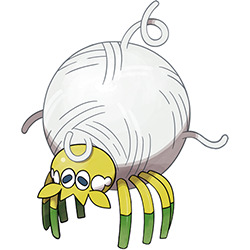
Tarountula is a really good Pokemon, both in terms of concept and execution. A spider that covers its abdomen with silk in a manner representative of a yarn ball works perfectly, and the design gets the point across immediately. This ball protectors them from their natural predators, which is a nice touch. Oddly enough, the yarn ball is actually removable, revealing a small structure at the end of its body that ties it more into its evo.
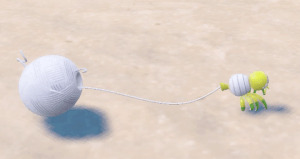
Visually, Tarountula's stylized eyes and almost sad-looking pupils make it extremely cute, which is compounded by its stylized pedipalps and simplistic legs (so simple it actually has eight of them, a rarity in Pokemon designs). White was an obvious choice for the silk, but this is accented by some green spots on the legs and a complimentary yellow color. Good stuff all around.

You'd expect something as round as Tarountula to evolve into an even rounder, larger spider, but it instead goes into a completely different direction by becoming an ogre spider, well known for looking like you took a jpg of a normal spider and stretched it out lengthwise. Ironically, some of Spidop's features that you would probably assume are inventions by GameFreak are actually just what ogre spiders are like, such as the paired limbs and spinning net traps to catch prey in.

While it might seem like it's lost the ball of yarn theme, it's actually just expanded on it by looking like a spool of thread. The resemblance between the two is more obvious without Tarountula's web ball, but some features remain the same, such as the green-tipped limbs, stylized pedipalps, and four pairs of eyes that wrap around the head. The black color of the eyes specifically resemble an ogre spider's comically large eyes, which are so adapted for night vision that they get destroyed by the sun each day and heal again by night. No, I am not making that part up.

In addition, Spidops also has a special ops kind of thing going for it, with a kind of bullet-proof vest on its chest, goggles, and a stealth-based operatus morandi. It would almost be too much, but it's subtle enough in the design that it thankfully doesn't feel too busy.
My only issues with Spidops are that the limbs feel weirdly flat at the ends, considering it uses them to hold web and snag prey—it might've been nice if they tapered into points, at least with the front ones. I also feel like the brown-on-green palette is muddied and bit low-contrast. Even just a lighter shade of brown/tan would've helped with this while still keeping it camouflaged.
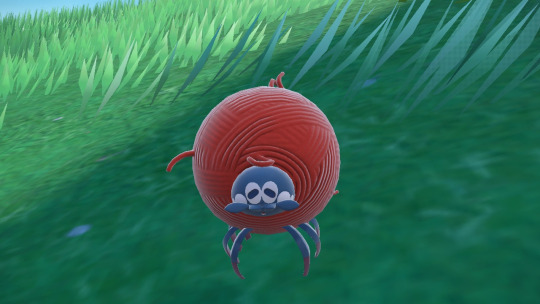
So overall, these are some really good spiders. The sewing theme is integrated into both in two unique ways, they have distinct body types, and Spidops keeps all the best attributes of the insect its based off of and adds an extra special ops theme for good measure. Tarountula also has a bangin' shiny, which doesn't hurt anything either.
76 notes
·
View notes
Text
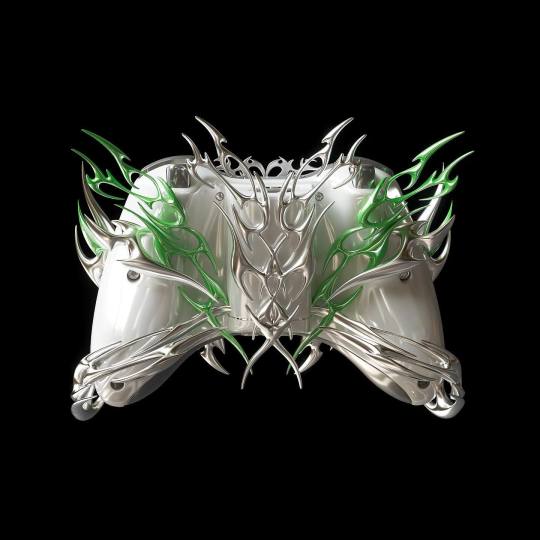
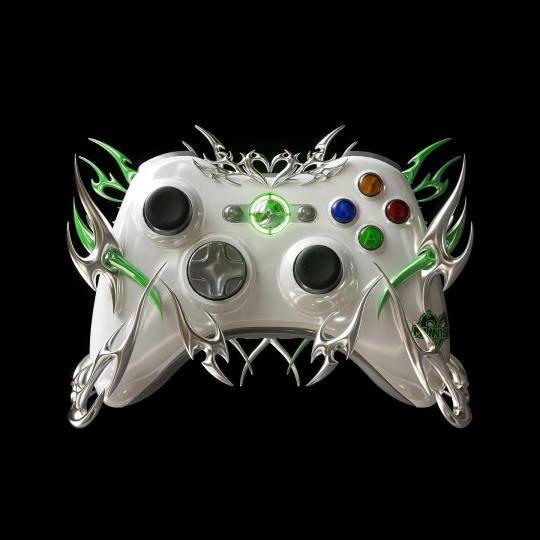
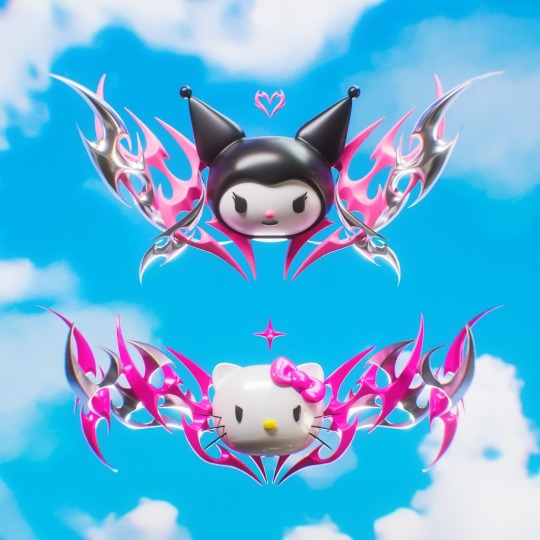
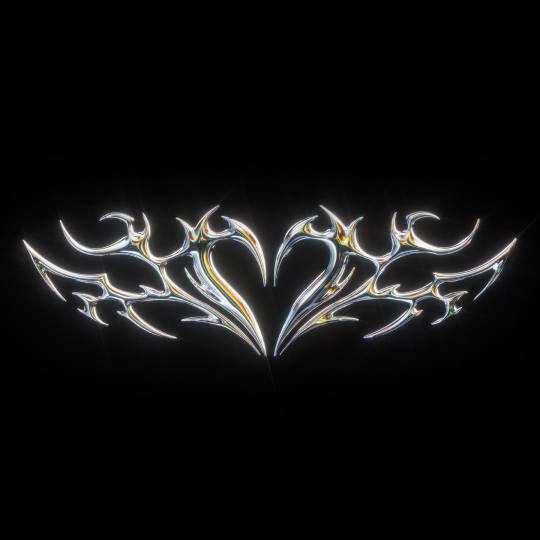
The Rise of Cyber Sigilism: The Modern Graphic Design Trend Defining Digital Aesthetics From the brighter days of graphic design, it seems new aesthetics appearing in the foreground are shaping and redefining the visual language of the industry. Arguably one of the most remarkable and potent trends in the present digital design cycle today, Cyber Sigilism is the convergence of mysticism, technology, and futuristic typography that has attracted the designers, brands, and artists into a new approach to visual storytelling. But what is all about Cyber Sigilism, and why is it all gunning down contemporary design space?
Defining Cyber Sigilism
Cyber-Sigilism is an aesthetic mode that integrates cyberpunk attributes with esoteric and arcane symbols. Here, the sinuous, digital essence of the cyber-realm stands beside the cosmic sense of ancient mysticism, adorned with intricate glyphs, abstract typographics, and a dark atmosphere replete with futuristic tone. Such a trend has become extravagant, mysterious, and otherworldly-it offers something truly demanding for designers wanting to reveal their full vigor in bright and conceptually lucid compositions.
The term derives from "sigil," defined as a symbol endowed with mystical powers and most commonly associated with magical arts and the occult. By fusing such symbols with the digital and cybernetic aesthetic, a near-ritualistic, visually complex aesthetic emerges, one that resonates with the digital age's preoccupations with technology, spirituality, and dystopian themes.
Why Cyber Sigilism is Trending in Graphic Design
Internet culture and alternative aesthetics. An age where digital subcultures thrive calls for online art communities to go beyond every possible measure of cultural creativity. Instagram, Tumblr, and Behance have become platforms that allow space for experimentations, where Cyber Sigilism may have gained currency due to its aura of mystery that speaks in defiance.
Nostalgic yet hyper-futuristic appeal. Cyber Sigilism embodies the nostalgia of early Internet aesthetics, from the templates of old-school RPGs, sci-fi interfaces, and projects of the Y2K era, while very much elevating them into hyper-futuristic realms, thus bridging between the visual styles coming out of the past and that of the future.
The mystical and the technological. While society becomes ever more engrossed in the exploration of digital technologies and spirituality, Cyber Sigilism provides ample opportunity to fuse the two. Reflecting themes of mythology, sacred geometry, and cyberpunk interface, the style resonates with audiences who are equally curious about the unknown and the digital world’s unbounded potentials.
Appealing to a counterculture. Many artists and designers today provide a contrast to the mainstream vomit of design. The chaotic, almost anarchic vibe of Cyber Sigilism is the opposite of the clean, Zen-like trends that have dominated branding and UI/UX design for far too long. In essence, it gives designers an extra, loud-hard statement in directing why one not only should reject proper rules of design but, dare say, almost so common as that.
Key Elements of Cyber Sigilism Design
If considering Cyber Sigilism for any design work, the following are critical considerations:
• Intricate Glyphs and Symbols: Mysterious markings compile cryptic languages and custom-made sigils; hence these are significant.
• High-Contrast Type: Angular, demanding, distorted, and glitchy typography would further create futuristic and ritualistic atmospheres.
• Dark-and-neon Color Palettes: This specific combination of tones builds a cybernetic-and-supernatural ambience with pitchdark blacks, electric blues, and neon greens.
• Layering Visuals and Textures: Interference from grids, noise textures, and abstract 3D renders-the layering technique complicates everything just a bit.
• Glitches and Digital Distortions: Static distortion, pixelation, and cybernetic interference allow the digital mystique to explode.
Final Thoughts
Graphic design is a constantly-changing domain, and Cyber Sigilism represents the avant-garde of the modern-day digital aesthetic landscape. This unusual and magnificent design style works to break accepted norms by mixing futuristic cyberpunk elements with ancient mysticism. Become a Cyber-Sigilism initiator, and whether you are a designer willing to hack the style or a brand willing to stand out, you'll ensure attention from a contemporary audience.
As this trend rises onward, one thing is certain: Cyber Sigilism is rewiring this visual identity for the digital age. (all works are courtesy of @mun15h on Instagram, go check him out! he does amazing cybersigil designs)
#cybersigil#blog#tumblrblog#sigilism#cybersigilism#kunaie#kuromi#trending#tech#graphicdesign#typography#hellokitty#sanrio
17 notes
·
View notes
Note
I would very much like to know about your deep dragon ideas
Wrow thank you for indulging me… i rly like these fuckin lizards… this isn’t gonna be very long cuz I don’t rly have that much to add from the original article on the wiki except some visuals I think are fun!!
Here are some headcanons I have about them:
They are flightless or nearly so, preferring to climb to get to high places instead of flying.
Their wings are instead used for mating displays and the leathery skin on their underside is shimmery purple instead of the matte deep purple of their scales.
The mushrooms that grow between their scales can be decorative as well as have practical uses. They integrate with the dragon’s breath systems to spread their spores as well as lending the dragon their daze-causing attributes. The mushrooms grow primarily on the dragons face and neck, but they can take hold on any part of the dragons scaly hide.
They use their long long necks to reach underwater and snap fish (and other things) up without having to fully submerge themselves. If they do end up having to, they stick their heads up above the water while walking/swimming thru it.
I hc their feeding patterns are very similar to snakes - they gorge for a day or so and then go back to their lair to rest and don’t have to feed again for another week (or two). This makes them pretty good at blending in with humanoids if they’re undercover in a city.
Leaving the underdark is risky for them as they don’t have the same adaptations a surface dragon has. Being unable to fly or withstand direct sunlight means they mainly travel at night but since they’re not slithering around in caves and stuff like they’re used to it’s slow-going.
In my brain I take the cool 5e neck mushrooms and smush them with the prancy dragon from the 3e art.
Look at this guy

8 notes
·
View notes
Text
I just realized I can post about anything I want.
Did you guys know I'm a therian? I'm a wolf. I have been ever since I was a kid. And I do integrate this into my spiritual practice. You don't have to like therians. You can think about them what you want, honestly. I'm happy, I'm healthy, and I'm also a really cool wolf.
I've realized that visualizing myself in wolf form has actually helped me do some pretty intense magic. I think it's because I allow myself to be more authentic like that and I am holding back less on allowing myself to have darker attributes. I view the animal part of myself as a representation of the 'dark side' of my nature, while my human part is the light one. Instinct vs intellect. Animal and human. Combined in me.
I feel really comfortable identifying as a therian nowadays but I've never shared it online, mainly because I haven't known that label for very long even though it always applied to me in some way. Also because I've seen the shit other therians get online for simply... existing. But I've decided now that other people's opinions don't really matter because they don't know me at all, so, there's that.
My deities do know about this part of me and have helped me a lot in accepting it and figuring out in what way this identity shows up in my day-to-day life, but also my practice. So I'm happy to announce that I'm a spiritual therian!
#therian#alterhuman#witchcraft#personal rambles#If you've got a problem with therians just kindly don't interact with this post thanks#pagan witch#canine therian
17 notes
·
View notes
Note
love your aesthetic post! vale and jorge… truly another level of divas. i do appreciate it when riders are committed to being visually identifiable on track. curious about your thoughts on the ass patches as part of the aesthetic?
also iirc marc’s cartoon ant was designed by the same guy who did vale’s turtle + stuff (back when he was managing his merch), it used to be on his helmets when he first started motogp. rip cartoon ant… another victim of sepang 2015 😔
(aesthetic post) ass patches very cute distinctive motogp thing!! like the cheesy championship celebrations... or hand grabbing on cooldown laps... or how the leathers have weird humps and look deeply awkward to walk in but inexplicably motogp keeps making the riders shoot almost all the promo material in them... tbh motogp really did need valentino because the sport is just conceptually too fruity to be allowed to remain the reserve of the hyper masculine sphere. like it's a shame that it's still just heterosexual men riding those bikes - but at least it got that sorely needed injection of camp and fun. actually I should've mentioned the ass patches thing in the original post because of course that too is something valentino heavily influenced, concurrently with a similar evolution in motocross (x)
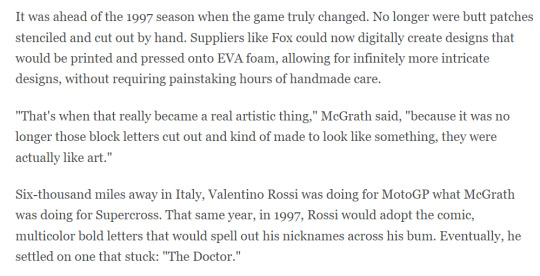
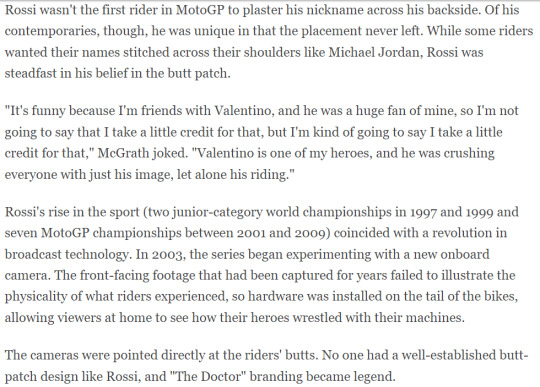

the camera thing is also funny and I kinda want them to keep doing it forever, just a very dumb motogp thing that adds to the specific quirky appeal of the sport. ik on this website they're appreciated as like. showcasing an attractive attribute of the male form. which obviously I personally have no real thoughts about but if they introduced dyke riders I think I'd probably be pro. idk I think they should have dyke riders
anyway on the cartoon ant thing. that does sound about right, I kinda suspected it might have been another casualty of sepang but did not want to spread Misinformation On The Internet and couldn't find a source. so. though I will say I also can't really remember seeing that ant on stuff 2013-15, idk in general it kinda feels like marc could've integrated it into more stuff. and if he didn't want a cutesy cartoon ant post-2015 fallout, he should've gotten himself another ant!! just ANY stylised ant. I feel like having an animal associated with you is such an easy slam dunk in terms of branding... acosta's doing a good job with it right now, like he's got a cute stylised shark and it's something you could reasonably see yourself buying merch for and it's just something fun they're associated with
in general I really am just pro riders having Things. I also think jorge's 'the martinator' thing very finely straddles the line between cringe and camp... and camp ofc in the truest sense is failed seriousness, like it's very campy in the disconnect between the attempted coolness and the profound silliness of what we are witnessing. idk part of the joy of motogp 2 me is watching vinales dress up as a gorilla between my fingers or hiding my face in my hands as pecco pulls out a guitar or sliding off my chair and hitting the mute button whenever marc starts dancing on podiums. the artifice and the performativity and the drama is what gives the sport life... it wouldn't be the same if it weren't so dumb
#casey ofc was the 'hardly anyone'. mr shoulder patch over here presumably thought it was too uncouth#and even he folded in 2011. presumably another thing we can blame repsol for#one more casey aesthetic point i forgot to make in that post - the ducati leathers always had the ITALIAN FLAG running down the sleeves#like YES haha yes sickos. again he was a completely unwilling half of a deeply symbolically rich rivalry he did just show up for#//#brr brr#batsplat responds#//at#//currt#another bit of vale aesthetic i skipped over in that post is the not using the number one thing#like you would not believe reading about the martin choice that only six premier class champions didn't switch their numbers#it's so few i can list them off the top of my head. but his influence is such that despite only being the second rider to stick with his#now every time somebody goes for the one it's like. a big deal. the way journalists talk about it as if it's this brave statement!! anyway#idk how true this is but i do remember journos speculating marc fired alzamora partly bc of like. lack of similar brand growth to valentino#which is the kind of thing i aggressively do not care about but i would support more cute symbols. the girlies want cute symbols#//brr brr
9 notes
·
View notes
Text
THE DUS MAHAVIDYAS IN TANTRA SADHANA
The Dus Mahavidyas, or the "Ten Great Wisdom Goddesses," are a group of ten aspects of the Divine Mother or the Supreme Goddess in Hindu Tantric tradition. Each Mahavidya represents a distinct manifestation of cosmic energy (Shakti) and embodies different attributes, ranging from the fierce to the benevolent. These goddesses are central to Tantra Sadhana (spiritual practice), as they symbolize various aspects of consciousness, transformation, and the cycle of creation and destruction.
The Ten Mahavidyas
1. Kali – The fierce goddess of time and change, often depicted with a dark, terrifying form. Kali represents the power of destruction, necessary for renewal and transformation. She is also the force that dissolves the ego, helping the practitioner transcend the material world.
2. Tara – The goddess of compassion and protection. She guides devotees through difficult times and leads them toward spiritual liberation. Tara is often seen as a savior figure who can ferry people across the ocean of suffering.
3. Tripura Sundari (Shodashi) – The goddess of supreme beauty and grace, also known as Lalita. She represents the energy of divine love, beauty, and creative power. She embodies the fullness of bliss and consciousness and is associated with spiritual attainment.
4. Bhuvaneshwari – The goddess of the universe or space (Bhuvana). She is the embodiment of the cosmos, representing the space within which all creation takes place. In Tantra, she symbolizes the realization of the unity of the self with the cosmos.
5. Bhairavi – The fierce and fiery goddess of destruction, similar to Kali but more directly associated with personal empowerment and inner fire. Bhairavi is the force that burns away ignorance and ego, transforming the practitioner’s consciousness.
6. Chhinnamasta – The self-decapitated goddess who symbolizes the cutting off of the ego and the realization of the void (Shunya). She is a symbol of self-sacrifice and awakening, teaching the balance between creation and destruction in the spiritual journey.
7. Dhumavati – The goddess of poverty, darkness, and death, representing the inauspicious aspects of existence. Dhumavati shows the devotee the reality of suffering and the impermanence of life, guiding them to transcend worldly attachments.
8. Bagalamukhi – The goddess of paralyzing speech and action. She is worshipped to gain control over enemies, both external and internal (such as negative thoughts). Bagalamukhi represents the power of stillness and the ability to immobilize obstacles in the path of spiritual progress.
9. Matangi – The goddess of inner knowledge, speech, and music. Matangi is associated with the power of thought, communication, and creativity. She represents the outcast and those who live outside societal norms, showing that wisdom can be found in unconventional places.
10. Kamala – The goddess of wealth, abundance, and prosperity, similar to Lakshmi. Kamala embodies material and spiritual wealth, showing that prosperity is not separate from the divine but can be integrated into spiritual practice.
Tantra Sadhana with the Mahavidyas
In Tantra Sadhana, practitioners engage in rituals, meditations, and mantras specific to each Mahavidya to unlock her unique powers and qualities within themselves. These practices often involve:
1. Mantra Japa – Reciting specific mantras associated with each Mahavidya.
2. Yantra Puja – Worshipping sacred geometric diagrams (yantras) representing the goddess.
3. Visualization – Meditating on the form of the Mahavidya, her attributes, and her qualities to invoke her presence.
4. Offerings – Presenting items like flowers, incense, and food to the goddess as a form of devotion.
5. Tarpana (Offering of Water) – Offering water to the goddess as a form of purification.
Symbolism and Significance
The Mahavidyas collectively represent a complete spectrum of divine energy, including the dark, the fierce, the nurturing, and the compassionate. They symbolize the multifaceted nature of reality and consciousness. Through the worship of these goddesses, practitioners aim to overcome dualities, such as good and evil, creation and destruction, or pleasure and pain, and experience the non-dual nature of the Divine.
Liberation from Fear: Many of these goddesses represent terrifying forms of the Divine, but their worship is intended to help the practitioner overcome fear and attachment, leading to spiritual liberation (Moksha).
Transformative Power: The Mahavidyas are seen as powers of transformation, both at the personal and cosmic levels. They help the sadhaka (practitioner) face and transform their deepest fears, desires, and ignorance.
Inner and Outer Wisdom: The Mahavidyas offer wisdom not just in the spiritual sense, but also in worldly matters, such as success, prosperity, and relationships. The practices associated with each Mahavidya lead to insights that help balance spiritual growth with worldly responsibilities.
The Dus Mahavidyas are powerful goddesses who represent the diverse manifestations of Shakti in Tantra. Worshipping these goddesses in Tantra Sadhana is a path to deeper self-realization, the transcendence of ego, and the ultimate experience of divine unity. Each Mahavidya has her own unique energy, teachings, and sadhana methods, and together they provide a comprehensive spiritual path for the practitioner.
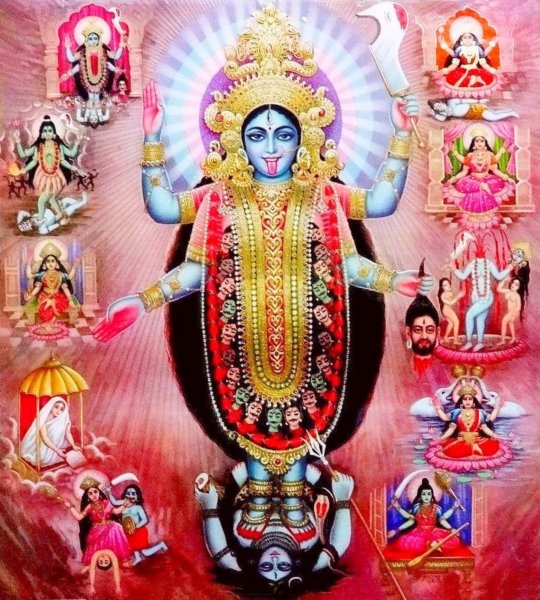
16 notes
·
View notes
Text
Zenless Zone Zero Version 1.4 "A Storm of Falling Stars" Special Issue | Hoshimi Miyabi: Behind the Scenes with the Dev Team (2/2)
Special Effects
When designing the special effects for the Frost attribute, we wanted them to feel uncanny, intricate, and mysterious to match its fantastical background.
In terms of color, as Frost is characterized by flowing Ether turbulence, it couldn't simply be an ordinary blue. Thus, we started with an ice-blue base and incorporated various tones of magenta and indigo to create an unusual and eerie blue that is rarely seen in nature.
In terms of form, we didn't want to just mimic the usual flame-like effects. After several rounds of preliminary development on its style, we made the edges of the Frost effect more stylized and comic-like. The addition of black-and-white stars not only reflects the meaning of "star" (Hoshi) in Hoshimi Miyabi's name but also shows the unique, original style of her attacks, avoiding the impression of being merely a recolored flame or appearing flat and paper-like.
▼Tiny Tailless's Special Effects: Before and After
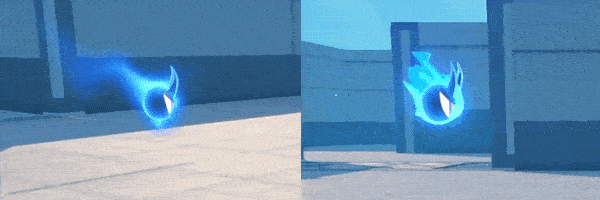
For the special effects of Tiny Tailless, we've taken a technical leap from the original released version by combining film industry software with game engines for the first time. Typically, flame-like effects are limited to extending along an object's path of motion. However, our specially designed "gaseous flame" effect simulates the chaotic dispersion of gas in multiple directions, making the "gaseous flame" of Frost and the eerie aura of Tailless more delicate and ethereal.
▼Early-Stage Concept Art for Miyabi's Hair Strand Effects

For the special effects on the strands of Miyabi's hair, the effects generated by the system alone lacked fluidity, while purely 2D effects couldn't achieve a 360-degree, flawless performance during actual gameplay. After several rounds of preliminary development, we decided to combine the advantages of both approaches by manually sculpting key Frost effect models using 2D design principles. You can think of it as ice sculpting — but animated.
After several months of work, we created a total of 150 hand-sculpted Frost models for Miyabi using 3D effect software to ensure smooth, dynamic performance. In the end, we integrated nearly 200 special effects files to portray Miyabi's unique Frost attribute, making it look as if every strand of her hair is "ignited" with Frost when she uses her skills.
▼Miyabi Hand-Sculpted Hair Strand Effects Demo

The visuals shown are still in development and are not representative of the post-release version.
>> Official Hoyolab post <<
9 notes
·
View notes
Text
The sounds of Tron-
Something that is often looked over is the fact that Tron not only has a connection with early computing but with early gaming as well. Not just because one of the characters makes games and runs a arcade, video games are absolutely integral to the world. In fact they make up a good portion of how the system looks and functions!
For example most of the transport, ships, and weapons we see come from video games, mainly Flynn’s but extends into encoms catalog. In the vernacular it’s common to mention it as well “video game warriors” “Gonna make you play video games” “video game simulation” etc. but you didn’t need me to tell you this.
The way video games impacted and shaped the digital world of Tron absolutely plays a hand in how seamless it translates into the two tie in Arcade cabinets. Though heavy on the grid bugs they’re beautifully decorated and similar to the games as we see them on screen/would translate in real life. The music stings come straight from Wendy Carlos’s work for the film, to the extent the game contains the entirety of Anthem. [Listen]
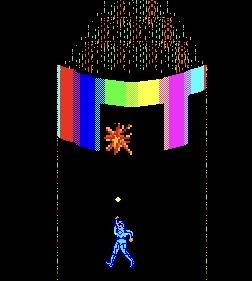
Sound cue’s and combat-
Part of what makes the sound and style of the game so accurate to the movie is the sound design. Like in old games there is a sound for everything. Every movement has its own sound, it sounds silly as things in real life also have noise but if you’ve ever played any retro game you know what I’m talking about.
One of the best examples of this is when Flynn is tossed into the cell and stumbles around, there’s a metallic echo to his footsteps. In combat it’s the same thing —very distinct sounds to go with every action. A lot of what older games are is pattern recognition- both visual and audio, certain music loops or sound cues help you get better at the game. Another good example is Tron casting his disc, blocking throws etc- if you know what a disc sounds like you can better dodge etc. I also like how they have almost a ceramic sound when Ram plays with his.

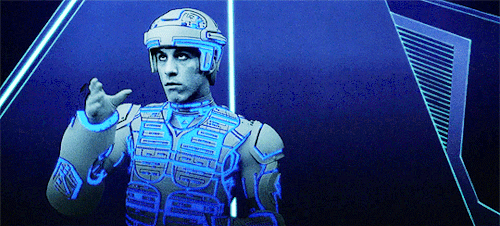
Nothing is more video game than De-resolution itself! The death cry and slowly breaking into bits before getting reabsorbed. You can hear the noise off screen and know what happened, game over.

Apart from video game comparisons I do have such a genuine love for the sound design of the film and how much it fleshes out the world. The blips and bloops of energy flowing through the system. The sounds of a working computer. There’s a dial up esc noise when Flynn is beamed in and judging by the guards reactions it’s not different from a how a regular program would enter/travel between systems. Programs get to make funky little computer noises in my heart 💕(another inhuman attribute I think they deserve, they’re like us in so many ways but then… aren’t.)
I know it’s probably just because it’s older recording equipment but occasionally programs will get a grainy feedback/radio style grain to their voice. I’d like to think it’s intentional- especially considering Legacy does this too (going so far for it to be what some sound like all the time)
The way sound is utilized in the movie is a incredibly underrated aspect of what makes the movie so good.
#tron#tronblr#tron 1982#Tron meta#video games#love that Pac-Man is canon- has a cameo#retro gaming#retro arcade#sound effects#sound design#tron worldbuilding#worldbuilding#game grid#master control program#Tron game#Tron soundtrack#wendy carlos#Tron lore
64 notes
·
View notes
Text
Future-Proof Your Brand: Why a Holistic Digital Marketing Strategy Matters in 2025
An in-depth guide by Digitalized Era
In the post-cookie, AI-driven landscape of 2025, piecemeal tactics are no longer enough to keep a brand visible, relevant, and profitable. Whether you run a local bakery in Jacksonville or a SaaS start-up in London, you need a holistic digital marketing strategy that ties every channel—SEO, social, paid ads, content, email, and web development—into one cohesive growth machine.
1. The Shift From “Channel Thinking” to “Customer Journey Thinking”
Old model
“We need Facebook posts.”
“Let’s run a Google Ads campaign this quarter.”
New model
“Sarah discovers us on TikTok, reads a blog we rank for on Google, joins our email list, and finally converts through a retargeting ad.”
This journey mindset forces you to optimise touchpoints together rather than in silos—exactly what Digitalized Era’s 360-degree process delivers:
Site Audit & UX checks
Deep market + keyword research
On-page & technical SEO
Cross-channel content mapping
Unified paid + organic reporting
Continuous CRO (Conversion Rate Optimisation)
2. Data Privacy & First-Party Data: The 2025 Reality
By the end of 2024, Chrome will have deprecated third-party cookies. Brands that fail to build first-party data pipelines will pay up to 35 % more for the same ad results. Digitalized Era helps you:
Capture consent with value-driven lead magnets
Segment subscribers in GDPR/CCPA-compliant workflows
Deploy personalised email drips that nurture, upsell, and retain
Result: lower acquisition costs, higher lifetime value.
3. AI Is Only as Good as Your Strategy
Tools like ChatGPT, Midjourney, and Google Gemini can accelerate content production—but they can’t replace:
Brand voice & POV
Strategic keyword selection
Human-centred storytelling
Our content marketing team blends AI efficiency with senior-level editorial oversight to create assets that rank and convert. Expect:
Long-form pillar pages
Social micro-content repurposed from cornerstone blogs
Data-rich infographics coded for fast mobile load times
4. Local, National, or Global: SEO Tactics That Scale
Local SEO – GMB optimisation, NAP consistency, hyper-local schema
E-commerce SEO – faceted navigation fixes, Shopify/Woo Commerce technical audits
International SEO – hreflang mapping, currency/region-specific content
Digitalized Era’s proprietary reporting dashboard shows real-time rank shifts across markets so you can allocate budget where ROI is highest.
5. Paid Media Is No Longer “Set & Forget”
Average CPCs rose 19 % last year in the US. To stay profitable you need:
Intent-driven keyword clusters, not vanity terms
AI-augmented bid strategies with human QA
Cross-channel attribution (PPC + organic + email)
Our PPC specialists iterate weekly, pausing under-performers and reallocating spend to winning ad sets—so every rupee, dollar, or pound works harder.
6. UX-Focused Web Design: Your New Sales Rep
A 0.1-second improvement in load time can boost conversions by 8 %. Digitalized Era’s design & dev squad builds:
Mobile-first, Core Web Vitals-optimized sites
Shopify, WordPress & Wix builds that integrate seamlessly with CRM and marketing automation
Accessibility-compliant interfaces (WCAG 2.2)
Beautiful and built to rank.
7. Measuring What Matters
Vanity metrics (likes, impressions) don’t pay the bills. We align on KPIs tied directly to revenue:
Qualified leads generated
Customer acquisition cost (CAC)
Average order value (AOV)
Customer lifetime value (CLV)
Return on ad spend (ROAS)
Our live dashboards deliver clarity, not confusion.
8. Success Stories
Leather Made In Italy moved from zero top-100 keywords to page-one dominance. Prevail Clothing scaled organic traffic 3× in six months. Cozyts saw Instagram engagement jump 220 % after a visual revamp.
Your brand could be next.
9. The Digitalized Era Advantage
✔ End-to-end expertise under one roof ✔ 24/7 support via phone (+91 674 357 6892) or email ([email protected]) ✔ Transparent, package-based pricing for SMEs and start-ups ✔ Offices in the US, UK, and India for truly global coverage
Ready to Transform Your Business?
Turn every click into a customer. Schedule a free 30-minute strategy call today:
📞 +91 674 357 6892 📧 [email protected]
Digitalized Era—your gateway to digital excellence. Let’s make 2025 your breakout year.
2 notes
·
View notes
Text


The Caduceus: Hermes Symbol of Harmony and Awakening
Hermes and the Caduceus
The Caduceus is primarily associated with Hermes Trismegistus, the Greek god known for being a messenger, guide of souls, and protector of merchants, shepherds, gamblers, liars, and thieves.
The symbol consists of a short rod entwined by two serpents and topped with a pair of wings, embodying the diverse and dynamic attributes of Hermes.
According to myth, the Caduceus originated in a specific episode involving Hermes.
One day, while traveling, Hermes came across two serpents entangled in a violent conflict. The serpents, locked in battle, were a symbol of discord and chaos. Observing their strife, Hermes sought to bring peace between them.
With a simple, yet profound gesture, he threw his rod between them as a mediator would step into a conflict.
The serpents, rather than continuing their fight, wrapped themselves around the rod in a double helix formation and their fighting ceased.
This act not only separated them but transformed their aggression into a dynamic balance, creating a new symbol of harmony and equilibrium.
The wings at the top of the rod signify the divine nature of the intervention and the elevation of the solution from earthly disputes to heavenly peace.
This transformative moment in mythology conveys deep symbolic meanings.
The serpents, traditionally symbols of wisdom, renewal, and healing due to their ability to shed their skin and renew themselves, here represent the dual forces of nature and life.
Their harmonious entanglement around the rod, which itself symbolizes authority and control, visually captures the balance between these forces.
This depiction illustrates the principle that through wise intervention and diplomatic action, balance and harmony can be achieved, transforming destructive energy into a constructive outcome.
The Caduceus carries layers of symbolism that delve into the nature of duality, healing, and transformation.
The two serpents coiled around a central staff encapsulate a visual depiction of balance and union of opposites, a theme prevalent in many philosophical and spiritual teachings.
Integration of Opposing Forces
The dual serpents of the Caduceus, spiraling around the central staff, visually signify the integration of opposing forces, a concept pivotal in many philosophical systems.
This integration is not merely a passive coexistence but an active unification that leads to greater wholeness and stability.
In many cultures, serpents are seen as embodying opposites — being both earth-bound and capable of transcendental knowledge.
Their union around the staff symbolizes the potential for reconciling such differences to foster unity and peace.
Symbol of Mediation and Peace
Hermes, wielding the Caduceus, guides the chaotic forces represented by the serpents towards reconciliation and unity.
Thus, the Caduceus symbolizes the transformation of conflict into peace and order, embodying the potential for wise intervention to harmonize opposing forces.
This portrayal of Hermes as a divine mediator illustrates how the Caduceus serves as a powerful emblem of peace, skillfully bridging gaps and mending rifts, whether in mythological tales or spiritual symbolism.
Balance and Equilibrium
In a broader spiritual and psychological context, the Caduceus mirrors the internal journey towards achieving personal equilibrium.
The intertwining snakes can be interpreted as the balancing of various aspects of one’s nature — rational and emotional, physical and spiritual.
This balance is crucial for personal growth and health, reflecting the adage that true healing and well-being are holistic processes that reconcile and align different facets of the self.
Transformation and Renewal
Serpents are also symbols of transformation and renewal, widely recognized for their ability to shed their skin and emerge anew.
This aspect of the serpent imagery within the Caduceus resonates with the concept of healing and medicine, where recovery and renewal are central themes.
The cyclic renewal of serpents provides a powerful metaphor for the medical process itself — the shedding of ill health to reveal wellness, the transformation of disease into healing.
Ascension and Divine Connection
The wings atop the Caduceus elevate its symbolism from earthly to divine, representing ascension, spiritual awakening, and the connection between the earthly and celestial realms.
In mythology, Hermes uses his winged sandals and helmet to traverse freely between the divine and mortal worlds, and similarly, the wings on the Caduceus suggest a bridging of gaps — between health and sickness, earth and sky, human and divine.
This aspect emphasizes the spiritual dimension of healing, suggesting that health is not only a physical state but also involves spiritual well-being and alignment.
The Caduceus as a Medical Symbol
The Caduceus is widely recognized today as a symbol of medicine, particularly in the United States.
This association began in the late 19th and early 20th centuries when military medical organizations adopted the Caduceus as part of their insignia.
The choice was influenced by its mistaken confusion with the Rod of Asclepius, the traditional Greek symbol for healing and medicine, which features only one snake and no wings.
The Caduceus’s adoption in medicine was largely due to its decorative symmetry and historical prestige, not its original symbolic meanings.
Caduceus Symbol, Rod of Asclepius, Doctor Symbol Art
55 notes
·
View notes
Note
i have autism and adhd, and have recently been going through what i assume is burnout. i attribute it to work, i work 9-6 five days a week, and it's honestly become exhausting having to constantly mask and present normal.
i'm mainly worried because i haven't had a new special interest in a while. my old ones, present for years, seem almost muted. i haven't had anything to hyperfixate over in such a long time, and the newest special interest i had (sharks) has felt faint almost the entire time. it's awful because i miss the love i felt for these special interests, they were so integral to me and as a result i feel like my sense of self is weaker.
is this normal? and do you have any tips on recovering from autistic burnout? thank you!!
Hi there,
I’m sorry to hear that you’re going through burnout. There’s a Recovery Plan that one of my favorite websites, Neurodivergent Insights, posted. Here are some Infographs. As well as some templates on how to build a recovery plan:
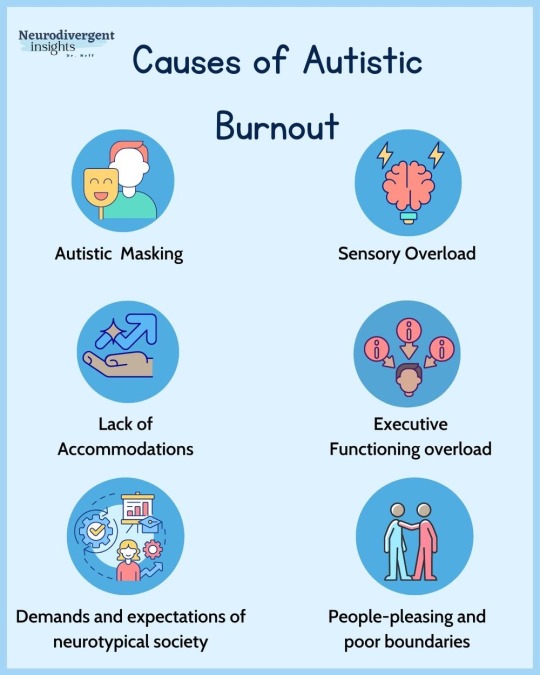



The link to this article will be below. I hope you find it helpful.
There’s also another article from Psych Central that gives some tips on Recovery:
How can you recover from autistic burnout?
Autistic burnout may feel confusing and overwhelming, but recovery is possible.
1. Remove obligations
It’s time to get a little ruthless with your schedule and commitments. If something isn’t 100% necessary, take it off your calendar for the near future.
Your new goal is to try to find as much downtime as you can, with fewer extracurriculars, work projects, and social events.
2. Participate in soothing activities
The idea is to participate in more hobbies that you enjoy, or those that promote a sense of relaxation — the things you might normally brush aside in your busy schedule.
You may find it recharging to:
spend time in nature
practice a calming visualization
exercise
draw
listen to music
journal
stretch
sit in silence with someone you love
Sensory interventions
“These can include compression, sitting in a dark closet specially outfitted for sensory bliss (pillows, quiet, dark), favorite smells, or textures,” Bédard says.
Noise-canceling headphones may also help you feel more grounded.
3. If you can’t sleep, rest
Autism can sometimes make sleep a challenge. Even if you’re not feeling tired, try to spend at least 8 hours a night in bed.
During this time, try to avoid watching the news or scrolling on social media. Instead, curl up with one of your favorite books or movies.
4. Practice self-compassion
“Try to be as gentle with yourself as possible,” O’Conner says. “If there are some things you can’t do, or have to say ‘no’ to right now, that’s OK.”
This article will also be below if you’d like to read through it.
Since you like sharks, I’ll also leave an article talking about ten facts about them. :)
I hope this helps you. I’m unemployed, so I don’t have the experience of working or the workplace in general.
Thank you for the inbox. I hope you have a wonderful day/night. ❤️
79 notes
·
View notes
Text

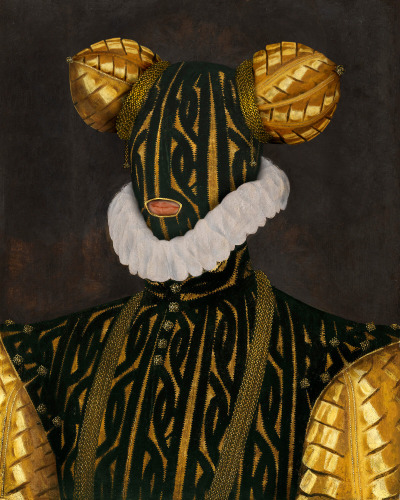
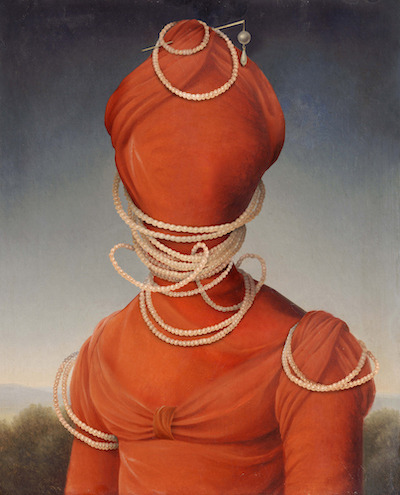
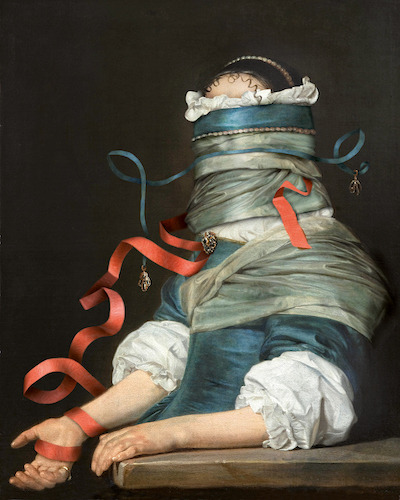

Volker Hermes, born in 1972, draws and paints powerfully and directly, with perseverance and a lot of humour. His pictures and drawings are always integrated into comprehensive projects, within which Hermes gets to the core of his subject in an almost scientific way. These projects include a multi-year preoccupation with the subject of portraiture and, more recently, with the subject of historical battle painting and seascapes.
ABOUT HIDDEN PORTRAITS
The “Hidden Portraits” are photo collages. I create them by editing photos of historical portraits, concealing in various ways the faces of the people portrayed.
The entire face is covered by an absurd mask, piled-up fabric or a ceremonial wig. But nothing is added to the paintings. All the changes come from within the original itself.
Portrait paintings are the only pictorial testimonies of people until the invention of photography. They are defining our visual idea of a historic society. However, portraits were a luxury and limited exclusively to a privileged elite. The intention in portrait painting was not merely to depict individuals, but rather their representational significance. Thus, opulent clothes and elaborate accessories and attributes in the paintings attest to high social standing.
However, when the faces of the protagonists are concealed, their individuality retreats behind the symbols of social significance and opulent surfaces that bear testimony to the splendour of the upper class.
But the conventions of dress that could be taken for granted at the time the portraits were painted have ceased to be part of our everyday reality. We no longer understand them and see only the likeness in the picture. For the viewer, the focus in my modified pictures shifts away from being the expression of an individual and towards the integration of painting in a social context. The “Hidden Portraits” examine the context of art as a means of representation and the relationship between image and reproduction.
75 notes
·
View notes